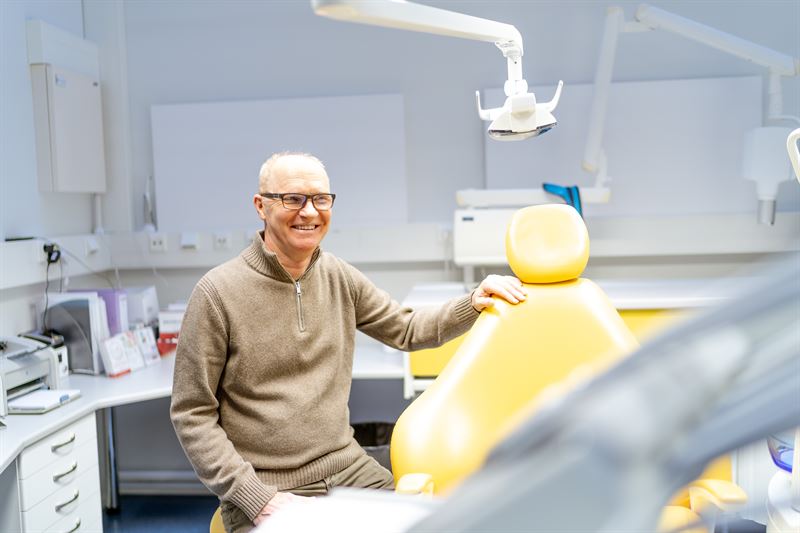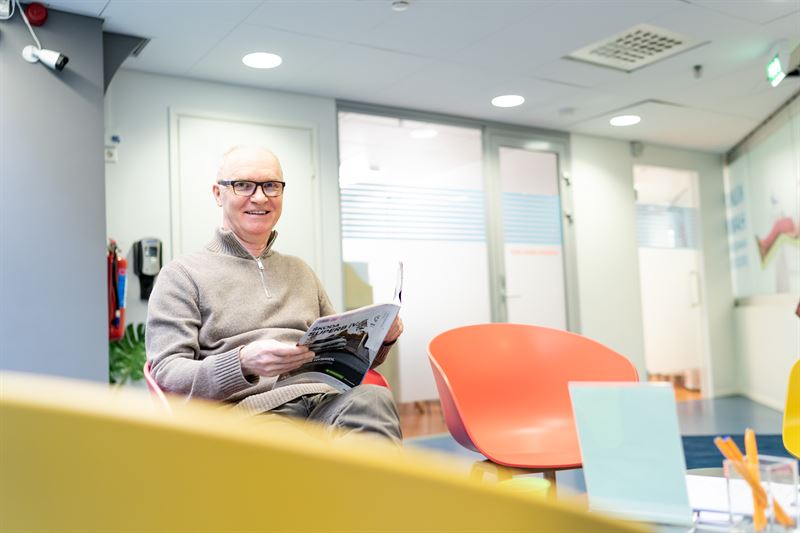Completing treatment workflows in-house with Planmeca solutions
Heikki Haikala has been working as a general practitioner for over 30 years. As one of the pioneers in incorporating CAD/CAM solutions into the dental practice in Finland, he has experienced firsthand how prosthetic dentistry has changed over the years. Today, Haikala’s clinic completes most parts of treatment workflows chairside with cutting-edge Planmeca technology.

In Kukontorin Hammaslääkärit dental clinic, Heikki Haikala works alongside four other general dentists, one maxillofacial surgeon and other dental staff. The clinic is fully equipped with Planmeca devices, which include dental units, a 3D imaging unit, an intraoral and a laboratory desktop scanner, a milling unit and a 3D printer.
Of course, Planmeca Romexis® software is at the heart of everything.
“We have equipped the clinic with state-of-the-art Planmeca devices so we can always treat our patients directly at our clinic, without the need to send them to other experts,” Haikala explains.
Planmeca equipment allows the clinic to plan and perform the treatments precisely, regardless of the specialty.
“Today, we are actually so used to working with Romexis, we almost take it for granted that we have all these great features available. Even the collaboration with partners is easy with Planmeca solutions."
"We use Romexis® Cloud to send data to our partners, for example for orthodontic treatment designing or radiological assessments,” Haikala says.
From medical school to Finnish forerunners in digital dentistry
Growing up, Heikki Haikala never thought about becoming a dentist. Following his father’s and brother’s footsteps, Haikala wanted to become a medical doctor and applied for the dentistry programme at the University of Oulu to get into the medical school.
However, he soon realised dentistry was exactly what he wanted to do after all.
“Before I started studying, I had only a vague idea of what dentists actually do. While I was studying, I realised I could work much more independently and with less bureaucracy as a dentist than in a medical hospital."
"It did not take me much time to figure out that I actually wanted to become a dentist, rather than a medical practitioner,” Haikala recalls.
Haikala worked as a general practitioner using traditional methods for over 15 years before he invested in CAD/CAM technology in 2010. Back then, he was the first person in Finland to purchase the E4D Dentist* system.
“Being the first one using the system was definitely a challenge, as I had no colleagues to ask for a piece of advice,” Haikala says now.
“I used all my spare time to train using the CAD/CAM system with the help of Planmeca personnel. Soon, I decided to hire a full-time dental technician to help me with the workload. I took care of the impressions and the technician was responsible for the restoration design and manufacturing. And the number of cases exploded right away!”
Digital dentistry has completely changed prosthetic dentistry
Over the years, Haikala has seen how prosthetic dentistry has changed. Metal is barely used for restorations anymore, and the speed of working is almost overwhelming.
“Digital dentistry has completely changed prosthetic dentistry, as we can now fabricate dental restorations independently in-house instead of collaborating with external partners. We used to wait for a crown for at least a week, but we can now manufacture it directly at our clinic in an hour,” Haikala says.
Since 2010, CAD/CAM technology has indeed taken huge steps forward: intraoral scanners have become faster and more accurate, milling materials have improved and the range of indications has extended. As the technology has evolved, Kukontorin Hammaslääkärit dental clinic has expanded its portfolio with the goal to use as little external services as possible.
Today, the clinic is able to produce for example high-quality 3-unit bridges, bite splints, surgical splints and guides, custom trays and design implant abutments in house.
According to Haikala, CAD/CAM technology is unbeatable especially in extensive cases that require multiple new crowns.
“We have seen several patients in need for new crowns for the entire jaw, as a result of difficult erosion. In these cases, we have been able to perform the treatment in only five weeks if the patient visited the clinic two times a week. Before, this kind of treatment would have taken several months,” Haikala describes.
“For me as a dentist, it is of utmost importance that the restorations we design and mill fit perfectly. With Planmeca devices, this has never been an issue.”
“The patients have also become more motivated because they begin to see results more quickly. Treatments are also much more comfortable because they only need to use temporary structures for a short time”, Haikala notes.

Heikki Haikala at Kukontorin Hammaslääkärit dental clinic.
Training is the key in incorporating new technologies
Kukontorin Hammaslääkärit was also among the first clinics in Finland to incorporate the Planmeca Creo® C5 3D printer into their dental laboratory. So far, the printer has been used especially in orthodontic treatment planning to create dental models and mock-ups.
Until now, partner laboratories have delivered the necessary orthodontic aligners, but Haikala plans to start manufacturing them in-house as soon as suitable 3D printing materials come available.
“We will also start manufacturing bite splints in-house soon.”
Digital technology has allowed dental clinics to expand their chairside production capabilities. As a result, dental professionals must constantly develop their competences and learn new skills.
“Even with digital dentistry, time is still limited. Therefore, we made the decision long ago to simplify our workflows so that I can concentrate on the clinical work while the technician takes care of the restoration design. For me, it is a bit bittersweet because I would also like to learn all new CAD/CAM features but would never have enough time to do everything properly,” Haikala sighs.
Haikala believes sharing the workload and training has been the key in incorporating new technologies successfully.
“From time to time, we see poor-quality restorations on patients who visit us to have them redone. I believe this might be because another dentist has tried to do everything by themselves, perhaps in a hurry and with limited resources.”
"Our dental technician is using Planmeca PlanCAD® Premium software, which has such an extensive tool selection. Learning to use all the available tools has required a lot of training. Representatives of Plandent, the local distributor of Planmeca equipment in Finland, have visited our clinic multiple times and helped us to get the most out the software,” Haikala says.
Haikala and his team have been working with Planmeca devices for a long time and know the local Planmeca representatives well.
“Although we have received offers from other dental equipment manufacturers as well, ending the well-functioning collaboration with Planmeca would be a catastrophe for us. We could not possibly get this kind of support from any other dental company,” Haikala states.
*The E4D Dentist system was integrated into Planmeca product portfolio in 2013 after Planmeca made a strategic investment in E4D technologies.
Copy: Mari Koivunen
Images: Dino Azinur
Planmeca Oy and Planmeca Group
Planmeca Oy is one of the world's leading dental equipment manufacturers with a product range covering digital dental units, CAD/CAM solutions, world-class 2D and 3D imaging devices and comprehensive software solutions. Headquartered in Helsinki, Finland, Planmeca’s products are distributed in over 120 countries worldwide. With a strong commitment to pioneering innovations and design, it is the largest privately held company in its field. Planmeca Oy is part of the Finnish Planmeca Group, which operates in the field of healthcare technology. The Group's turnover in 2019 was MEUR 770, and it employs nearly 2,800 people worldwide.
www.planmeca.com
Tags:



